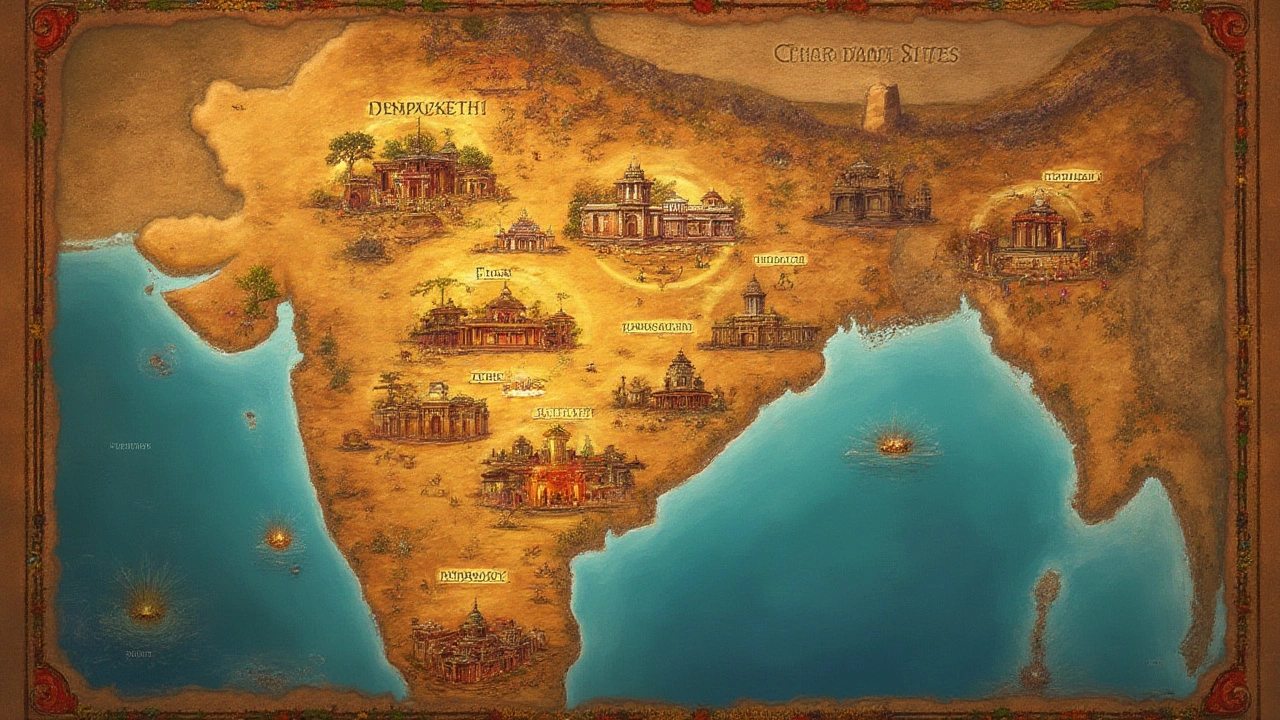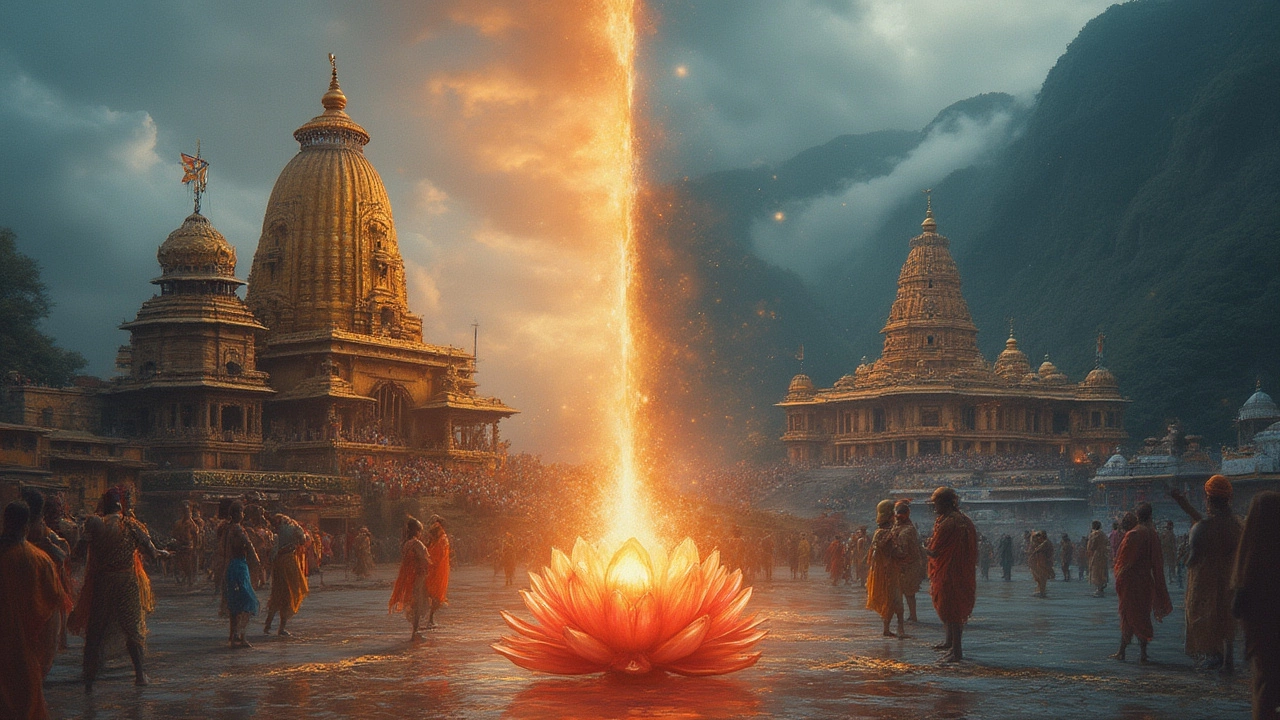Why Kedarnath Is Not Part of the Char Dham: Real Reasons & Historic Context
 Jul, 8 2025
Jul, 8 2025
Kedarnath has this mystical pull. Its snowy peaks, stories of Shiva, and heart-thumping trek turn it into a dream for many travelers. But try asking anyone during a chai break: is Kedarnath one of the 'Char Dham'? Most will confidently nod. Yet, that’s not exactly right—and the real answer is fascinating.
The Basics: What Is Char Dham versus Chota Char Dham?
If you’ve ever planned a temple road trip or scrolled mesmerizing Himalaya photos, you’ve probably seen both terms—Char Dham and Chota Char Dham. They sound similar, right? But they aren’t. Char Dham, the "four abodes," is a set of four ancient pilgrimage sites far apart from each other: Badrinath up north, Dwarka to the west, Jagannath Puri in the east, and Rameswaram way down south. These are considered the ultimate spiritual circuit—crossing India from tip to toe.
Chota Char Dham ("little four abodes") is a modern pilgrimage circuit in Uttarakhand, the heartland of hills, rivers, and legends. Here, the line-up includes Yamunotri, Gangotri, Kedarnath, and Badrinath. If you look closely, this 'Chota' version is much younger and caters mostly to those seeking salvation amid the Himalayas.
So, when someone lumps Kedarnath into "Char Dham," they’re blending two entirely different journeys. It's easy to see why—names overlap and temples like Badrinath play on both teams, but the difference is rooted in geography, tradition, and history.
The History: Mapping the Origins of Char Dham
Let’s hop in a time machine to the 8th century. The holy man Adi Shankaracharya was jazzed up about unifying Indian spiritual life. He’s the guy who picked the original Char Dham locations, choosing Badrinath, Dwarka, Puri, and Rameswaram. His picks weren’t random; each spot anchors a corner of India and honors a different form of Lord Vishnu, or his avatars. It was bold: the north-south-east-west road trip was designed to unite the country through worship.
Kedarnath, though steeped in ancient Shiva lore, didn’t make this OG list. In the Shankaracharya era, Kedarnath had its own local significance. It drew Shiva devotees, thanks to the jaw-dropping temple (built by the Pandavas, say legends) and the rugged Himalayan charm. But it didn’t get the national spotlight of a Char Dham seat. The reason: the Char Dham idea was focused around Vishnu shrines. Shaivites (Shiva followers) had separate circuits, like the Jyotirlingas—twelve ancient temples including Kedarnath.
Not until the British and modern travel did the Chota Char Dham emerge. Nineteenth-century texts, road explorers, and ever-growing faith blended the four locations—including Kedarnath—into a single Uttarakhand yatra. Suddenly, Kedarnath was in the limelight, but as a star of the Chota Char Dham, not the classic pan-India Char Dham.
A lot of folks confuse these pilgrimages today. Google 'Char Dham' and you’ll get pictures of Himalayan treks right along with beaches in Rameswaram. Blame the overlap on centuries of storytelling and the mass popularity of the high-altitude Uttarakhand yatra.

Kedarnath’s Place in Hindu Pilgrimage: Legends and Facts
Kedarnath isn’t missing out—it just plays a different game. Its temple is one of the twelve Jyotirlingas, which are sacred to Shiva, not Vishnu. The legend behind Kedarnath is epic: after the Kurukshetra war, the Pandavas came here seeking Shiva’s forgiveness. Shiva, always a bit elusive, disguised himself as a bull. The Pandavas caught him, but he dove underground, leaving his hump above—which became the temple’s main shrine. His other body parts popped up at temples around the region (collectively called the Panch Kedar).
This story makes Kedarnath a heavyweight among Shiva temples, drawing both pilgrims and adventure-hungry trekkers. Add to that the extreme location—no roads, only a steep mountain trail, and weather that can swing from sunshine to blizzard in minutes. The place is raw, dangerous, and beautiful, all at once.
The temple itself is ancient, built of massive stone slabs with no mortar. According to local stories, the temple withstood the 2013 floods that swept away everything else—standing unscathed, with a lone boulder said to have redirected the floodwaters. Every season, thousands risk the trek, some even bringing dogs or horses (my Maximus would love it, though he might not be thrilled going uphill for hours).
Kedarnath’s ritual calendar, too, is special. The temple only opens from April to November. In winter, snow blocks the path, so priests take the idol down to Ukhimath. This seasonal rhythm is different from the 'year-round' Char Dham locations.
Why the Mix-up? Modern Pilgrimage and Popular Culture
Social trends move fast, and so does travel. In the past few decades, more and more Indians—and now tons of international travelers—flock to Uttarakhand’s mountains for spiritual reasons or just for the trek. Tour packages, films (think 'Kedarnath,' the Bollywood movie), and news coverage boosted Kedarnath’s fame as a must-visit spirit quest.
In digital times, confusion blends in easily. Travel agencies, blogs, and posters often just call the Uttarakhand circuit 'Char Dham.' Maps get shared, tweets go viral, and 'Chota' sometimes gets dropped. But if you want to impress locals, or avoid embarrassing moments while talking to an actual priest at Kedarnath, it’s worth keeping the distinction clear.
Some tips to keep in mind:
- Char Dham means four pan-India sites picked by Shankaracharya (Badrinath, Puri, Dwarka, Rameswaram)—with a Vishnu focus.
- Chota Char Dham means a modern pilgrim route in Uttarakhand (Yamunotri, Gangotri, Kedarnath, Badrinath)—mixing Shiva and Vishnu shrines in a much smaller region.
- If someone says, “I did the Char Dham,” you might want to ask, “Which one?” Their answer could be Himalayan or all-India.

Making Sense of Kedarnath’s Unique Appeal
You don’t need to care about technical definitions to feel Kedarnath’s magic. Whether as part of the Chota Char Dham or as a standalone temple, it has this knack for transforming travelers. Maybe it’s the way you turn a bend and see the temple framed by raw rock and snow. Maybe it’s the almost primal satisfaction of making it there on your own two feet.
If you’re the curious type, there’s more to experience than just the trek and the temple. The nearby villages have their festivals and wild myths. Shopkeepers tell tales of devout pilgrims and wandering sadhus who vanished on the paths. Mountain dogs sometimes tag along for kilometers, almost as if the hills themselves are nudging you along.
For anyone sketching out a spiritual India tour, understanding the actual difference between the Char Dham and Kedarnath’s Chota Char Dham spot will keep you ahead of the curve. Next time someone says Kedarnath is one of the “main four,” you can smile and share a little bit of this wild, tangled history—maybe over a hot cup of chai after the long walk back down the hill.